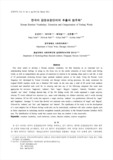

-
 * 본 문서는 배포용으로 복사 및 편집이 불가합니다.
* 본 문서는 배포용으로 복사 및 편집이 불가합니다.
미리보기
서지정보
· 발행기관 : 한국감성과학회
· 수록지 정보 : 감성과학 / 15권 / 1호
· 저자명 : 손선주, 박미숙, 박지은, 손진훈
초록
본 연구 1에서는 한국어 감정표현단어의 목록을 제작하고, 연구 2에서는 제작된 감정표현단어가 어떤 범주의 감정에 속하는지를 조사하였다. 연구 1의 한국어 감정표현단어 목록 제작을 위하여 연세대학교에서 제작한 '현대 한국어의 어휘빈도' 자료집으로부터 감정단어들을 추출하는 작업을 여러 단계에 걸쳐 시행하였다. 일상생활에서 빈도 높게 사용하는 감정표현단어를 선정하기 위하여 국문학 전공자와 감정연구자 12명이 참가하였으며, 총 504개의 감정표현단어들로 구성된 목록을 완성하였다. 연구 2에서는 80명의 대학생을 대상으로 각 단어가 '기쁨', '공포', '분노' 등 10개 범주(중성포함)의 감정 중 어느 감정과 관련 있는지 복수 선택하도록 하여 각 단어에 대한 감정 범주를 조사하였다. 단어들의 감정 범주 분석 결과, 504개 단어 중 426개 단어는 한 범주의 감정을 의미하였는데, '슬픔'을 나타내는 단어가 가장 많았으며, 다음으로 '분노', '기쁨' 순으로 나타났다. 다음 72개 단어는 두 감정 범주를 나타내었는데, '분노'와 '혐오', '슬픔'과 '공포' 그리고 '기쁨'과 '흥미'로 묶이는 단어가 많았다. 세 감정 범주를 보인 6개의 단어는 '놀람', '흥미', '기쁨'의 조합이 가장 높은 빈도로 나타났다. 본 연구는 일상생활에서 실제로 사용하는 감정표현단어 목록을 제작하고, 이에 기반을 두어 각 단어와 관련된 감정 범주를 복수의 감정 범주를 포함하여 규명하였다는데 의의가 있다. 본 연구에서 개발된 감정표현단어들과 각 단어에 대한 감정 범주 정보는 심리학 분야뿐만 아니라 이후 HCI 분야에서 언어적 내용에 기반을 둔 감정인식 연구에 활용될 수 있을 것으로 기대한다.영어초록
This study aimed to develop a Korean emotion vocabulary list that functions as an important tool in understanding human feelings. In doing so, the focus was on the careful extraction of most widely used feeling words, as well as categorization into groups of emotion(s) in relation to its meaning when used in real life. A total of 12 professionals (including Korean major graduate students) partook in the study. Using the Korean 'word frequency list' developed by Yonsei University and through various sorting processes, the study condensed the original 64,666 emotion words into a finalized 504 words. In the next step, a total of 80 social work students evaluated and classified each word for its meaning and into any of the following categories that seem most appropriate for inclusion: 'happiness', 'sadness', 'fear', 'anger', 'disgust', 'surprise', 'interest', 'boredom', 'pain', 'neutral', and 'other'. Findings showed that, of the 504 feeling words, 426 words expressed a single emotion, whereas 72 words reflected two emotions (i.e., same word indicating two distinct emotions), and 6 words showing three emotions. Of the 426 words that represent a single emotion, 'sadness' was predominant, followed by 'anger' and 'happiness'. Amongst 72 words that showed two emotions were mostly a combination of 'anger' and 'disgust', followed by 'sadness' and 'fear', and 'happiness' and 'interest'. The significance of the study is on the development of a most adaptive list of Korean feeling words that can be meticulously combined with other emotion signals such as facial expression in optimizing emotion recognition research, particularly in the Human-Computer Interface (HCI) area. The identification of feeling words that connote more than one emotion is also noteworthy.참고자료
· 없음태그
-
자료후기
-
자주묻는질문의 답변을 확인해 주세요

꼭 알아주세요
-
본 학술논문은 (주)코리아스칼라와 각 학회간에 저작권계약이 체결된 것으로 AgentSoft가 제공 하고 있습니다.
본 저작물을 불법적으로 이용시는 법적인 제재가 가해질 수 있습니다. -
해피캠퍼스는 구매자와 판매자 모두가 만족하는 서비스가 되도록 노력하고 있으며, 아래의 4가지 자료환불 조건을 꼭 확인해주시기 바랍니다.
파일오류 중복자료 저작권 없음 설명과 실제 내용 불일치 파일의 다운로드가 제대로 되지 않거나 파일형식에 맞는 프로그램으로 정상 작동하지 않는 경우 다른 자료와 70% 이상 내용이 일치하는 경우 (중복임을 확인할 수 있는 근거 필요함) 인터넷의 다른 사이트, 연구기관, 학교, 서적 등의 자료를 도용한 경우 자료의 설명과 실제 자료의 내용이 일치하지 않는 경우
“감성과학”의 다른 논문도 확인해 보세요!
-
문화성향-내외 통제소재 조합 유형에 따른 전역/국소 처리에서의 차이 12 페이지
동일 문화권에서의 문화성향(개인주의 vs. 집단주의)-내외 통제소재(내통제 vs. 외통제) 조합 유형에 따라 복합 자극에 대한 전역/국소 처리에서 차이가 있는지 검토하기 위해 자극 유형(복합도형과 복합문자)과 자극-자극 속성 일치 여부가 조작된 실험조건에서 실험참가자들이 보인 반응시간과 오반응률을 비교하였다. 본 연구의 주요 결과를 요약하면 다음과 같다. .. -
생체모방기술을 응용한 감성의류용 구조발색사와 직물의 물성 8 페이지
본 연구에서는 생체모방기술을 응용하여 감성의류용 구조발색사를 방사하고, 이를 사용하여 직물을 제직 감량 가공하여 이들의 발색성 및 촉감 물성을 측정하여 감성의류용 용도의 적용성을 확인하여 다음과 같은 연구결과를 얻었다. 삼각단면을 가진 37층의 폴리에스테르와 나일론을 교호로 적층한 구조발색사의 방사조건을 확립하였으며, 이 세 가지 사의 발색성을 multi .. -
개인화 프로세스를 적용한 실시간 감성인식 기술 8 페이지
본 연구에서는 개인 맞춤형 감성인식이 가능한 실시간 개인화 프로세스를 개발하였다. 설계된 개인화 프로세스는 실시간 생체신호 중립밴드 알고리즘과 사용자의 주관적인 감성응답을 실시간으로 입력받아 개인 감성룰베이스를 업데이트하는 과정을 포함한다. 실시간 감성인식을 위해 PPG(Photoplethysmography), GSR(Galvanic skin reflex).. -
감성기술 적용 성공사례 분석을 통한 감성콘텐츠 개발 방향 연구 12 페이지
최근 들어 감성기술은 제조업(제품), 서비스업(문화, 관광, 의료, 교육, 광고) 등 많은 분야에서 적용이 확대되고 있으며 차세대 유망기술로 등장하고 있다. 또한 문화는 게임, 전시, 공연, 스포츠, 관광, 디자인, 에듀테인먼트, 콘텐츠 유통 등 다양한 콘텐츠산업분야에 접목되어 기존산업의 고부가가치화에 기여하고 있다. 감성 기술을 이용한 문화의 콘텐츠산업 .. -
사용자의 정서 단어 분류에 기반한 정서 분류와 선택 방법 8 페이지
최근에 사용자에 의한 대량의 텍스트 데이터가 발생하면서 사용자의 정보, 의견 등을 분석하는 오피니언 마이닝이 중요하게 부각되고 있다. 오피니언 마이닝 중 특히 정서 분석은 제품, 사회적 이슈, 정치인에 대한 호감 등에 대한 개인적 의견이나 정서를 분석하여 긍정, 부정이나 행복, 슬픔 등의 정서를 분석하는 연구 분야이다. 정서 분석을 위해서 정서 차원 이론의..
문서 초안을 생성해주는 EasyAI

